The outrigger canoe is a type of canoe featuring one or more lateral support floats known as outriggers, which are fastened to one or both sides of the main hull. Smaller canoes often employ a single outrigger on the port side, while larger canoes may employ a single-outrigger, double-outrigger, or double-hull configuration (see also catamaran). The sailing canoes are an important part of the Austronesian heritage. They are also very popular in Puerto Rico. Unlike a single-hulled canoe, an outrigger or double-hull canoe generates stability as a result of the distance between its hulls rather than due to the shape of each individual hull. As such, the hulls of outrigger or double-hull canoes are typically longer, narrower and more hydrodynamically efficient than those of single-hull canoes. Compared to other types of canoes, outrigger canoes can be quite fast, yet are also capable of being paddled and sailed in rougher water. This paddling technique, however, differs greatly from kayaking or rowing. The paddle, or blade, used by the paddler is single sided, with either a straight or a double-bend shaft.
- lateral support
- hydrodynamically
- rowing
1. History
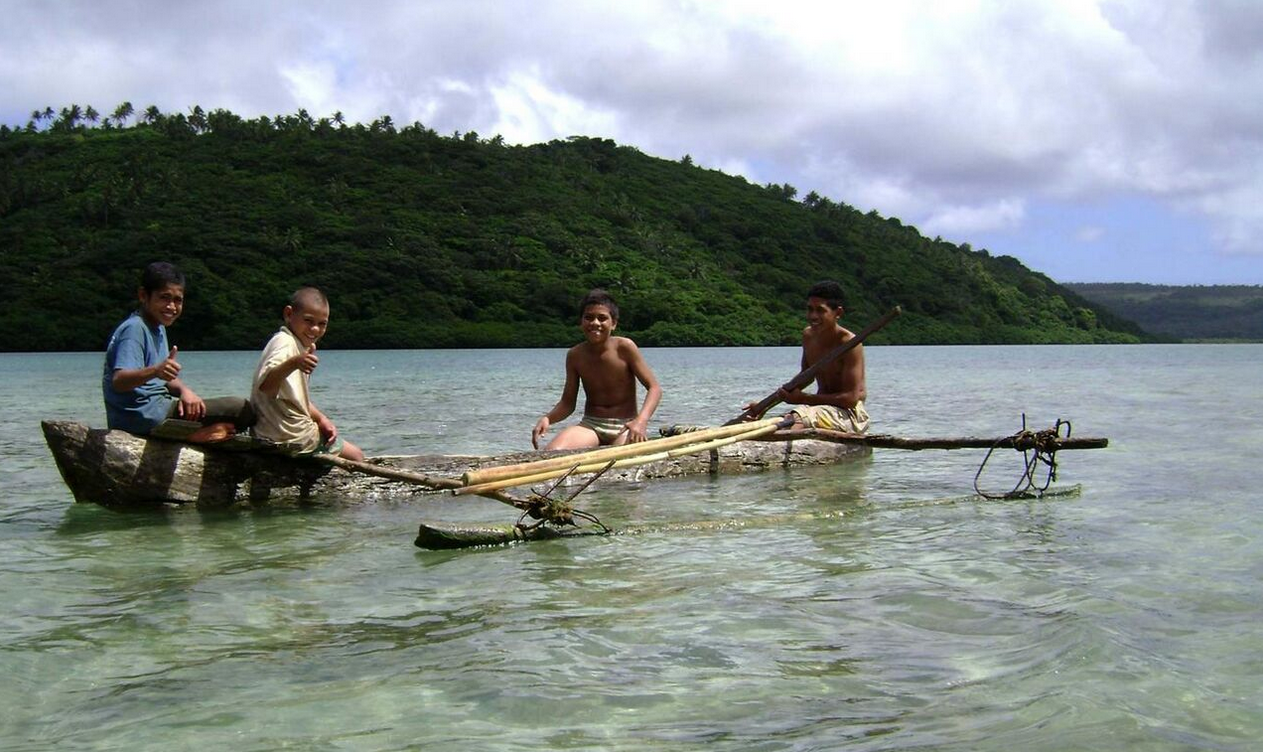


Outrigger canoes were originally developed by the Austronesian-speaking peoples of the islands of Southeast Asia for sea travel. They were used to transport these peoples both eastward to Polynesia and New Zealand and westward across the Indian Ocean as far as Madagascar during the Austronesian migration period. While today they can be found in East Africa (e.g., the ungalawa of Tanzania), the Austronesian peoples (Malagasy, Maritime Southeast Asian, Micronesian, Melanesian, Native Taiwanese, and Polynesian peoples) continue to be the primary users of the outrigger canoes.
Outrigger fishing canoes are also used among certain non-Austronesian groups, such as the Sinhalese in Sri Lanka, where they are known as oruwa,[2] as well as among some groups in the Andaman and Nicobar Islands.[3] The ethnological significance of this spread has been studied by James Hornell.
When Magellan's ships first encountered the Chamorros of the Mariana Islands in 1521, Antonio Pigafetta recorded that the Chamorros' sailboats far surpassed Magellan's in speed and maneuverability.
The Polynesian Voyaging Society has two double-hull sailing canoes, Hokulea and Hawaiiloa, and sails them between various islands in the Pacific using traditional Polynesian navigation methods without instruments. The Hikianalia and Alingano Maisu are other extant double-hulled voyaging canoes.
The technology has persisted into the modern age. Outrigger canoes can be quite large fishing or transport vessels. In the Philippines , outrigger canoes (called bangka or paraw) are often fitted with petrol engines. The links between seafaring and outrigger canoes in the Philippines extend through to political life, in which the smallest political unit in the country is still called "barangay" after the historical balangay outrigger boats used in the original migrations of the first Austronesian peoples across the archipelago and beyond.
2. Terminology and Linguistics
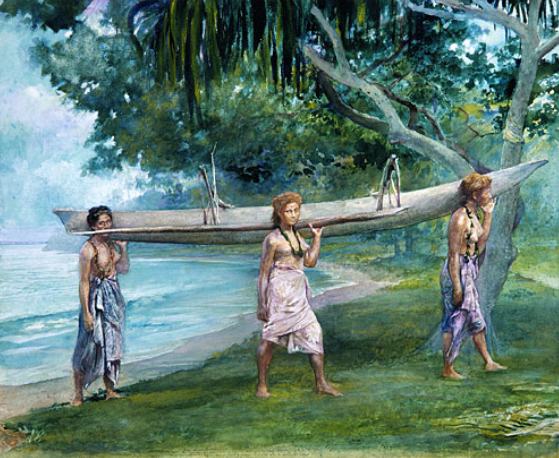
The reconstructed Proto-Austronesian word for the outrigger canoe is *waŋkaŋ. Cognates in modern Austronesian languages include: Ketagalan bangka; Filipino bangka; Indonesian bangka; New Zealand Māori waka ama; Cook Islands Māori vaka; Hawaiian waʻa; Tahitian and Samoan vaʻa; and Malagasy lakana.
The outrigger float is called the ama in many Polynesian languages (compare Hawaiian ama, Maori ama, and Samoan ama, all meaning 'outrigger float'), realisations of Proto-Malayo-Polynesian *saRman 'outrigger float'[4][5]. Similar terms also exist in other Malayo-Polynesian languages, such as Pohnpeian dahm, Yapese thaam, Ambonese Malay semang, all meaning 'outrigger float', as well as Chamorro sakman meaning '[a] large canoe - from Polynesia or Papua, [with] no outrigger, capable of carrying over 100 people'[6]. The outrigger boom—spars connecting the ama to the main hull (or the two hulls in a double-hull canoe)—are called ʻiako in Hawaiian and kiato in Māori (with similar words in other Polynesian languages), ultimately from Proto-Oceanic *kiajo or its doublet *kayajo both meaning 'outrigger boom' (compare Loinu kiec, Kiribati kiaro, and Tongan kiato, as well as Seimat ayas and Gedaged ayad, all meaning 'outrigger boom')[7][8]. In Philippine languages, the outrigger floats are called katig or kate, from Proto-Philippine *katiR.[9][10]
3. Types
Double-outrigger canoes are more prevalent in Southeast Asia and Madagascar . They have two outrigger floats connected to spars lashed across a single hull. They range in size from small vessels like the jukung, vinta, and the paraw; to medium-sized trading and fishing vessels like the balangay and basnigan; to very large warships like the karakoa and kora kora. In Philippine vessels, additional booms called batangan are usually added across the outrigger spars (tadik), in between the outrigger floats (katig) and the main hull (bangka).[10][11] In modern terminology, especially in leisure or sport boating, double-outrigger ships are usually termed trimaran or triple-hull ships.
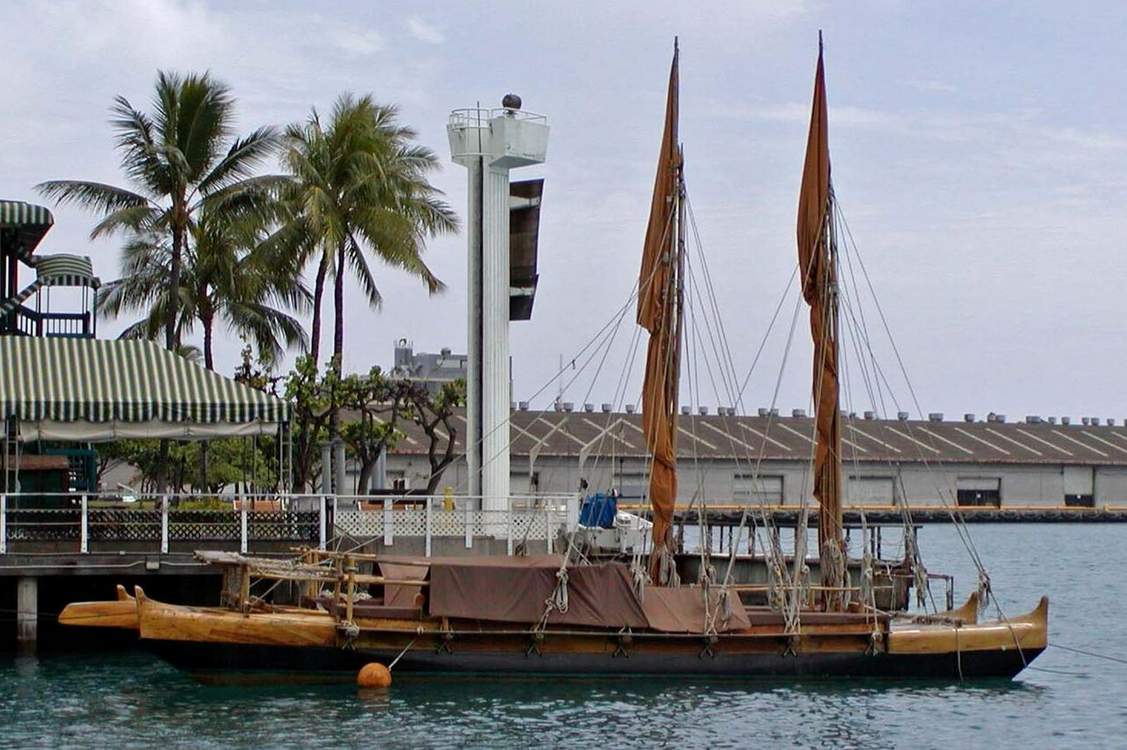
Single-outrigger canoes are more prevalent in Polynesia and Micronesia. Single-outrigger canoes have a single outrigger float (ama) connected to the main hull by spars called ʻiako (Hawaiian), ʻiato (Tahitian), or kiato (Māori). The ama, which is usually rigged on the left side, provides stability. The paddlers need to be careful to avoid leaning too far on the opposite side of the ama, as that may cause the canoe to capsize (huli or lumaʻi). A variant of single-outrigger canoes with two equal-sized hulls (instead of a hull and an outrigger float) is called catamaran or double-hull ships.
4. Modern Sport
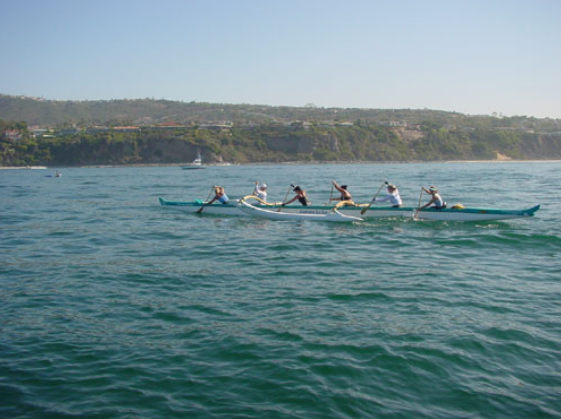
Outrigger canoe racing has become a popular canoeing sport, with numerous clubs located around the world. Outrigger Canoe Racing is the State sport of Hawaii and an interscholastic high school sport. In Hawaii, entire families participate in summer regattas with age groups from keiki (children as young as 6 with an adult steersperson) and age 12 through age 60+.
Major races in Hawaii include the Molokaʻi Hoe 43 mi (69 km) men's race from the island of Molokai to Oahu across the Kaiwi Channel, Na Wahine O Ke Kai (same race for women) and the Queen Liliʻuokalani Race held near Kona on the Island of Hawai.
In modern sport outrigger canoeing, ships are classified according to the configuration and number of the hulls and the number of paddlers, including the OC1, OC2, OC3, OC4 and OC6 (with the respective number of paddlers using a single-hull outrigger canoe), and the DC12 or OC12 (with twelve paddlers using a double-hull outrigger canoe, two six-person canoes rigged together like a catamaran). Outriggers without a rudder are referred to as V1, V2, etc. (where V refers to vaʻa).
Six-person outrigger canoes (or OC6) are among the most commonly used for sport use; single-person outrigger canoes (or OC1) are also very common. Two and four-person outrigger canoes are also sometimes used, and two six-person outrigger canoes are sometimes rigged together like a catamaran to form a twelve-person double canoe.

Modern OC6 hulls and amas are commonly made from glass-reinforced plastic. However, some canoes are made of more traditional materials. In Ancient Hawaii, canoes were carved from the trunks of very old koa trees. These canoes, although rare, are still very much in use today. The ʻiako are usually made of wood; the ʻiako-ama and ʻiako-hull connections are typically done with rope wrapped and tied in an interlocking fashion to reduce the risk of the connection coming completely apart if the rope breaks.
Modern OC1 hulls and amas are commonly made from glass-reinforced plastic, carbon fiber reinforced plastic, and/or Kevlar to produce a strong but light canoe. OC1 are often made with rudders operated by foot pedals. More traditional designs do not have rudders. OC1 commonly use ʻiako made of aluminium, with a mechanism for quickly assembling and disassembling the canoe (snap buttons, large wing nuts, etc.).
4.1. Roles
In an outrigger canoe, the paddlers sit in line, facing toward the bow of the canoe (i.e., forward, in the direction of travel, unlike rowing). The seats are numbered from 1 (closest to the bow) to the number of seats in the canoe, usually 6. The steerer (or steersman or steersperson) sits in the last seat of the canoe (seat 6 in the common OC6) and, as the name indicates, is primarily responsible for steering. The paddler sitting in seat 1 is called the stroke (or stroker) and is responsible for setting the pace of the paddle strokes. The stroker should have a high level of endurance to keep the rate (the number of strokes taken in a given amount of time) manageable for whatever the situation may be. The first two positions may also be involved in certain steering manoeuvers. This usually involves the draw stroke. During a tight turn, the one seat might poke to make the canoe turn the opposite way. In the middle of the canoe (seats number 3 and 4) known as the powerhouse are the strong and powerful paddlers. Any of the 2 can be the 'caller' who directs when to switch over their blades, when to pick up or slow down the stroking pace, etc. Whoever is caller must have very good leadership skills and know how to think off the top of their heads in any situation. Every position has an important role to play in the canoe.
In an OC1, the single paddler must also steer the canoe. Some OC1s have rudders operated by foot pedals, while OC1s without rudders must be steered by drawing and paddling as needed for steering purposes while paddling to move the canoe forward.
Steersman
A good steersman is able to maintain the straight attitude of the canoe throughout the course of a race, and also keep the boat and the crew safe in rough sea conditions. S/he may also take advantage of water conditions to gain extra speed by surfing. The steersman uses a single bladed steering paddle which has a larger blade than a standard outrigger paddle, is built stronger, and has less or no bend in its shaft. S/he steers by the following methods:
- Poking: holding the paddle vertically against the side of the canoe, causing drag on that side to cause the canoe to turn that direction. (left to go left and right to go right)
- Drawing: paddling at a 45 to 90-degree angle to pull water under the canoe, causing the canoe to turn the opposite direction.
- Posting: holding the paddle in the water out to the side with the forward edge angled opposite to the desired turn direction, usually as a prelude to drawing.
- Paddling: by applying power on one side of the canoe, the steersman can influence to a small degree which way the canoe will turn. Paddling also increases the total power moving the canoe forward compared to the other steering methods. The steersman should try and paddle as much as possible so he or she doesn't slow down the canoe by contributing to the amount of weight in the canoe.
A steersman also skippers the canoe and instructs all other paddlers as necessary. As an outrigger canoe is a long narrow canoe with the steersman placed at the very end, the steersman must give instructions sufficiently loudly and clearly for the entire crew to hear. From a water safety perspective the steersman should also be among the most experienced crew members, and be knowledgeable with the waterways and weather conditions, relevant maritime rules and other safety considerations such as the use of personal flotation devices, rigging of the canoe, placement of paddlers in the various seating positions, and recovery from a huli by righting the canoe and bailing out the water. The steersman should also be able to keep the ama down during rough water.
Paddlers
Paddlers use single-bladed paddles, usually with single or double bent shafts. The paddling stroke is similar to that of most other racing canoe paddling strokes, involving primarily core and lat strength. Generally, each paddler paddles on the opposite side from the paddler in directly front (for example, in an OC6, paddlers in seats 1, 3, and 5 paddle on one side, while paddlers in seats 2 and 4 paddle on the other side). All paddlers switch sides simultaneously on a call from one who is the designated caller. The steerer may paddle either side or switch sides as needed for steering purposes. The steersman will also switch sides to keep the ama from popping up and capsizing the canoe.
Stronger paddlers are typically placed in the middle of the canoe, while paddlers with the most endurance tend to be placed at the front, as the lead paddler sets the pace for the crew. All other paddlers synchronize their strokes to the paddler in front of them (whom they can directly see).
In rough water, it is often desirable to have a paddler with steering skill in seat 5 (of an OC6), to allow for the steerer to have that paddler also take steering strokes if needed in some situations. In conditions when the boat is surfing, the stern of the canoe will be so far out of the water that seat 5 will have to keep the boat on course. A seat 5 paddler with steering skill can also assist in preventing a huli by staying on the ama side during a particularly rough stretch of water.
In water rough enough to splash into the canoe, paddlers also need to pay attention to the water level in the canoe, report the situation to the steerer, and bail out the water as necessary. Paddlers also need to know how to recover from a huli under the steerer's direction.
In a quick turn situation, paddlers at the front may also be instructed to une (poke steer, causes the canoe to turn the opposite direction) or kahi (post and draw steer, pulls the canoe to the side where this is done) to help bring the canoe around a turn quickly.
4.2. Racing
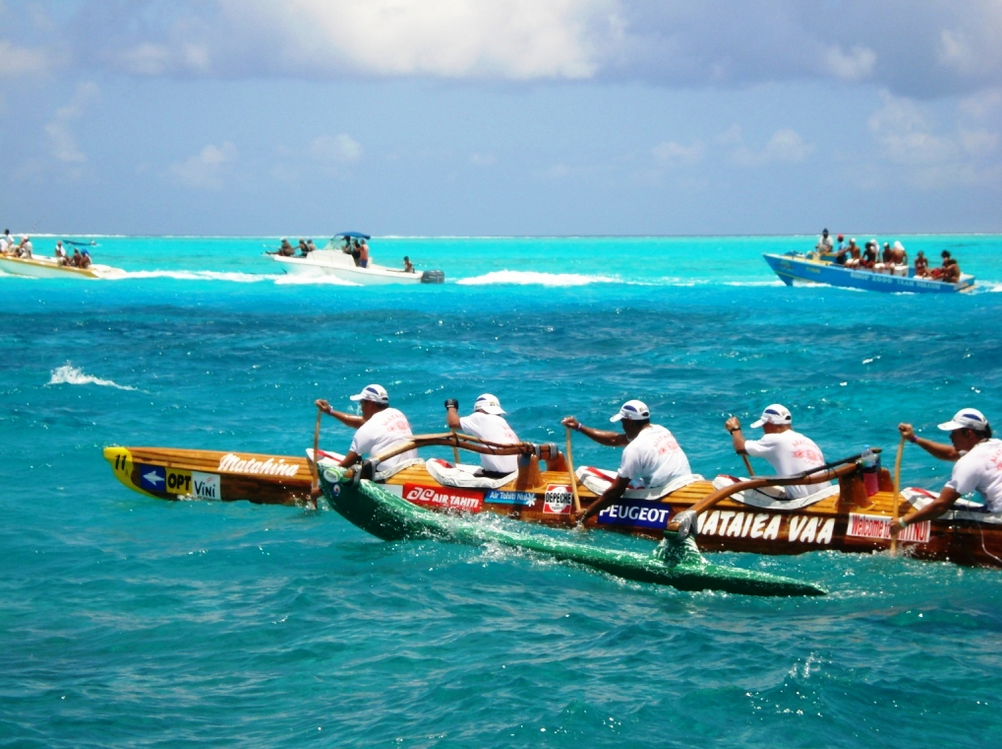
The length of a race ranges from short sprints (e.g., 250–500 metres for the OC1 and the OC12, 500–2000 metres (usually includes turns) for the OC6) to longer events, including marathons (e.g., 42 kilometres). A number of races are raced over distances that far exceed 42 kilometres, including the Molokaʻi Hoe that crosses the Kaiwi Channel between the islands of Molokai and Oahu in Hawaii. However, long-distance races of 20 to 30 kilometres are more common, with shorter 5 to 8 kilometre courses typically being offered to novice paddlers and those under 20 years of age.
Longer races involving the OC6 often involve paddler replacements, which involve exit and entry to the canoe directly from the water while the canoe is underway (this is called a water change). Typically, nine paddlers form a crew, with six paddling the OC6 and the other three resting, drinking, and/or eating on an escort boat. Replacement typically occurs at 20 to 30 minute intervals; the escort boat drops the relief paddlers into the water ahead of the OC6, which is steered toward them. The relief paddlers climb in on the ama side as those they are replacing roll out into the water on the opposite side. The escort boat then picks up the paddlers in the water so that they can rest, drink, and/or eat before they, in turn, relieve some of the paddlers in the OC6.
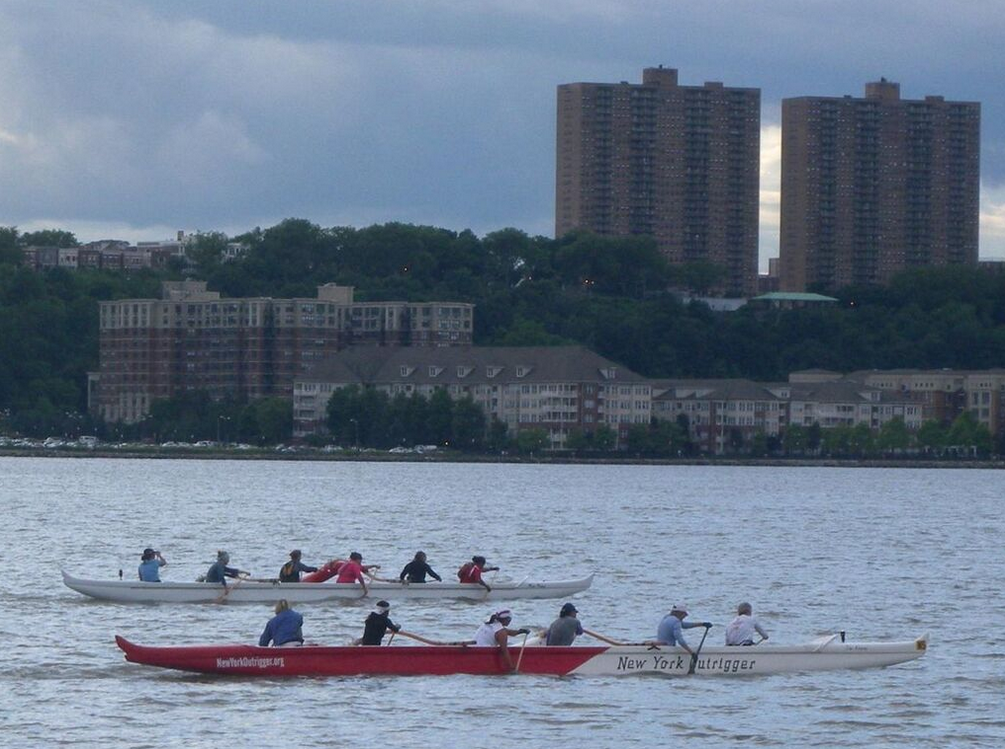
The longer races are typically conducted in the open ocean, e.g., between islands in the South Pacific. The Molokaʻi Hoe in Hawaii, The Hamilton Cup in Australia,[12] The Vaka Eiva in Rarotonga (Cook Islands),[13] The Motu2Motu in Aitutaki (Cook Islands)[14] and the Catalina Channel crossing in California [15] are four examples of races involving water changes.
Paddlers and crews are usually classified by gender and age. Gender classification is typically straightforward, with male, female, and coed classifications, with the latter being a crew with equal numbers of male and female paddlers (different rules may apply to nine-person coed crews doing a race with paddler replacements). Age classifications typically include youth divisions like 19-and-under, 16-and-under, etc., master divisions with minimum ages typically starting at 35 or 40 years of age, and an open division which allows paddlers of any age. A novice division for paddlers with less than a specified number of years of race experience (usually one or two) may also exist in a given association.
In some races, a particular type of outrigger canoe, usually a more traditional design for the region, may be given its own racing classification. For example, races in Hawaii have a koa division, while southern California has a Bradley OC6 division and northern California OC1 sprint races have a traditional (no rudder) division.
There are several outrigger racing organizations in the United States. They include the East Coast Outrigger Racing Association (ECORA), the Hawaiian Canoe Racing Association (HCRA), the Northern California Outrigger Canoe Association (NCOCA), the Southern California Outrigger Canoe Association (SCORA), and several more.
The content is sourced from: https://handwiki.org/wiki/Engineering:Outrigger_canoe
References
- Francisco Ignacio Alcina (1668). Historia de las islas e indios de Bisayas. https://trove.nla.gov.au/work/21366897?selectedversion=NBD197673.
- Kapitän, Gerhard (May 1989). "Records of Native Craft in Sri Lanka—I: The single outrigger fishing canoe oruwa—Part 2.2: Rowed, paddled and poled oru". International Journal of Nautical Archaeology 18 (2): 137–149. doi:10.1111/j.1095-9270.1989.tb00185.x. https://dx.doi.org/10.1111%2Fj.1095-9270.1989.tb00185.x
- Irenäus Eibl-Eibesfeldt, Land of a Thousand Atolls: A Study of Marine Life in the Maldive and Nicobar Islands, World Publishing Co., Cleveland and New York, 1964.
- Blust, Robert; Trussel, Stephen (December 2013). "The Austronesian Comparative Dictionary". Oceanic Linguistics 52 (2): 493–523. http://muse.jhu.edu/article/530554.
- Blust, Robert; Trussel, Stephen (2018-01-14). "*saRman outrigger float". http://www.trussel2.com/ACD/acd-s_s1.htm#30758.
- Blust, Robert; Trussel, Stephen (2018-01-14). "*saRman outrigger float". http://www.trussel2.com/ACD/acd-s_s1.htm#30758.
- Blust, Robert; Trussel, Stephen (2018-01-14). "*kiajo outrigger boom". http://www.trussel2.com/ACD/acd-s_k.htm#30633.
- Blust, Robert; Trussel, Stephen (2018-01-14). "*kayajo outrigger boom". http://www.trussel2.com/ACD/acd-s_k.htm#30634.
- Lawrence A. Reid (1994). "Unravelling the linguistic histories of Philippine Negritos". in Tom Dutton & Darrell T. Tryon. Language Contact and Change in the Austronesian World. Trends in Linguistics, Studies and Monographs 77. Mouton de Gruyter. p. 456. ISBN 9783110127867. https://books.google.com.ph/books?id=xOlI8czLshIC&dq=katig+philippines+austronesian&source=gbs_navlinks_s.
- Patricia Calzo Vega (1 June 2011). "The World of Amaya: Unleashing the Karakoa". GMA News Online. http://www.gmanetwork.com/news/scitech/content/222283/the-world-of-amaya-unleashing-the-karakoa/story/. Retrieved 4 May 2018.
- Emma Helen Blair & James Alexander Robertson, ed (1906). The Philippine Islands, 1493-1898. http://www.gutenberg.org/cache/epub/15157/pg15157-images.html.
- "Clash of the Paddles - Hamilton Island Events". hamiltonisland.com.au. http://www.hamiltonisland.com.au/hamilton-cup/.
- "Vaka Eiva - Home". vakaeiva.com. http://www.vakaeiva.com/.
- "Motu 2 Motu Aitutaki". Facebook. https://www.facebook.com/motu2motu.
- "SCORA - Catalina Crossing - US Outrigger Championships". hcatalinacrossing.org. Archived from the original on 2015-07-30. https://web.archive.org/web/20150730021657/http://www.catalinacrossing.org/.
